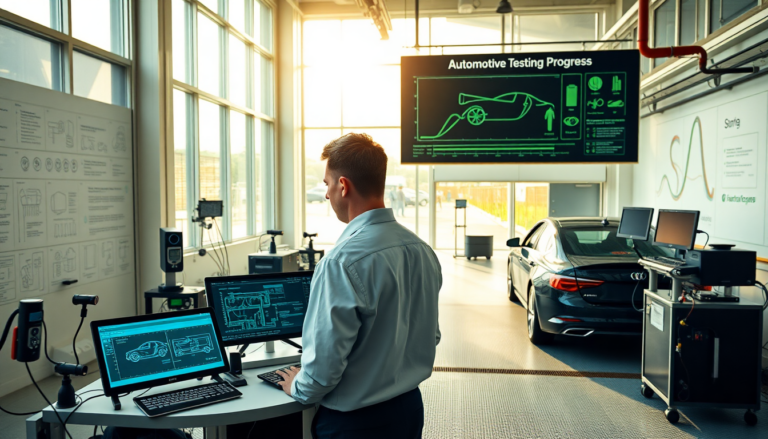Argomenti trattati
The automotive industry is going through a remarkable transformation, driven largely by breakthroughs in electrification and the increasing complexity of vehicle systems. As engineers face these new challenges, the need for precise and innovative testing solutions has never been more critical. So, what are the latest developments in automotive testing and measurement, and how are these innovations helping engineers navigate this evolving landscape? Let’s dive in!
The Current Landscape of Automotive Testing
In recent years, the automotive sector has undergone a significant shift, particularly with the surge in electric vehicles (EVs) and hybrid electric vehicles (HEVs). This transition calls for advanced testing methodologies to ensure that new technologies meet performance, safety, and regulatory standards. Automotive engineers are now tasked with developing intricate systems that integrate high-speed data communication, power management, and electric propulsion.
To grasp the demands of modern automotive testing, we need to examine a landscape defined by rapid technological advancements. With cutting-edge electronics and software becoming an integral part of vehicles, engineers are confronted with greater complexities in system validation and debugging. The importance of robust testing solutions cannot be overstated; they play a vital role in streamlining the development process and enhancing product reliability. Have you ever wondered how engineers ensure each component works seamlessly together?
Utilizing state-of-the-art oscilloscopes, signal analyzers, and protocol decoders is essential for capturing and analyzing the intricate signals produced by these advanced systems. The ability to visualize and comprehend these signals is crucial in diagnosing issues and making sure that vehicles perform as intended, especially concerning electric and autonomous technologies. Isn’t it fascinating how much technology goes into ensuring our vehicles run smoothly?
Emerging Challenges in Automotive Testing
As vehicle architectures continue to evolve, engineers face various challenges that can hinder the testing and development process. One of the most significant challenges is the increased complexity of in-vehicle networks, which must support numerous high-speed communications protocols simultaneously. How do engineers keep track of all these protocols to ensure everything integrates seamlessly?
Moreover, the electrification of vehicles brings with it new testing requirements related to power electronics and energy management. Engineers must evaluate the performance of components such as traction inverters, battery management systems, and electric motors, necessitating specialized testing equipment that can handle the unique characteristics and challenges associated with these technologies.
Additionally, as the industry races towards autonomous driving capabilities, validating and testing sensors and control systems becomes increasingly crucial. Ensuring these systems communicate effectively and respond accurately under various conditions is vital for achieving safety and reliability in autonomous vehicles. What can be done to ensure these systems are foolproof?
Innovative Solutions for Modern Automotive Testing
To tackle these challenges head-on, innovative testing solutions have emerged, significantly enhancing the capabilities of testing and measurement equipment. Advanced oscilloscopes and signal analyzers are now designed to deliver industry-leading signal fidelity, deep memory, and sophisticated triggering capabilities. These features empower engineers to capture and debug subtle anomalies across high-speed data buses and power systems. Isn’t it amazing how technology can help pinpoint even the smallest issues?
Furthermore, integrated software solutions allow for synchronized analysis across diverse domains, helping engineers identify root causes more efficiently. This holistic approach to testing not only reduces the time to resolution but also bolsters the overall reliability of the automotive systems being developed. How much time could be saved with these advancements?
Tektronix, a trusted partner to leading automotive manufacturers, stands at the forefront of providing tools and insights that facilitate the development of safe and reliable vehicles. By offering comprehensive solutions that span everything from R&D to production environments, Tektronix plays a pivotal role in helping automotive engineers stay competitive in an ever-evolving market.
Conclusion: The Future of Automotive Testing
The future of automotive testing is undoubtedly linked to ongoing advancements in electrification and connectivity. As the industry continues to evolve, the demand for innovative testing solutions will only strengthen. Engineers must be equipped with the right tools and insights to effectively navigate the complexities of modern vehicle architectures.
By embracing cutting-edge technologies and methodologies, automotive engineers can rise to the challenges posed by electrification, autonomous driving, and advanced connectivity. This proactive approach will ultimately lead to the development of safer, more efficient, and reliable vehicles that can thrive in the rapidly changing automotive landscape. Are you excited to see where this technology will take us next?

